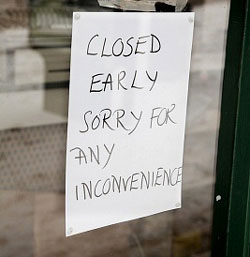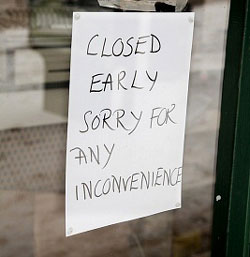Andy Trainer
5 Sep 2013
How to Close a Project Early
Having to close a project earlier than anticipated can be a big disappointment and source of concern for Project Managers.
On the other hand, premature closure should be considered as a learning opportunity and even a chance to salvage useful products other than those planned.
With this in mind, the PRINCE2 methodology is focused on controlling every aspect of a project, including its closure, and gleaning as much use out of work done as possible.
Closing a project early can become the best course of action in a number of situations, e.g.
- If an unforeseen dependency comes into play
- If the budget for time or cost goes too far beyond agreed tolerance
- If the budget has to be reconsidered due to reasons beyond the project itself (e.g. programme or corporate budget cuts)

Without using a technique such as PRINCE2, when it becomes evident that a project is not going to be seen to the planned end, it may be tempting to just let it drop.
A PRINCE2 Practitioner qualification will teach you the importance of closing the project in a controlled manner - and how to salvage as much as possible from the work already done.
When a project is closed before the expected product is finished, the Project Manager must complete a number of predetermined processes: request premature closure, prepare premature closure (once permission is granted by the Project Board), and update relevant documents (the Issue Register, Issue Report and Project Plan).
The amount of work (time and resources) required will depend on the scale of the project, and at what point in its life cycle it is closed.
Documentation
As with preparing for planned closure in PRINCE2, certain documentation must be produced when preparing early project closure:
- If there is an Exception Report, this must be updated, along with the Issue Report and Issue Register, with notes on the premature closure instruction. Lessons learned from risks that may be transferred to the Programme or other projects are passed on.
- The Project Plan must be updated with final costs and timescales.
- A Product Status Account will be completed to document products that have been finished or still in development, which may be of use to other projects. Once the Product Status Account has been examined by the Project Board, an Exception Plan may be drawn up for any work that needs to be completed as a result.
- The Lessons Log will have the reason for early closure added to it.
- A request is sent to the Project Board, asking them to release project staff and also when to expect the final invoices from the supplier.
- The project will still be reviewed and evaluated in terms of its performance against the Project Initiation Document and Business Case.

How to Manage Early Closure with Staff
It’s very important for the Project Manager to closely manage staff morale in the event of project closure.
Depending on the scale of the project and the organisational structure, premature closure could mean anything from dented egos to redundancy.
The main thing to remember is to reward effort and encourage staff to look to the future.
Make sure you communicate with the team the reasons for the closure, and follow up with them to ensure they can learn lessons from what happened and that nobody feels any undue responsibility.
Communicating the positive aspects of what the project achieved, or what can be learned from non-achievement, will make people less worried about being associated with a ‘failed’ project.
To further get to grips with the basics of project closures, come on our Introduction to Project Management Course.
